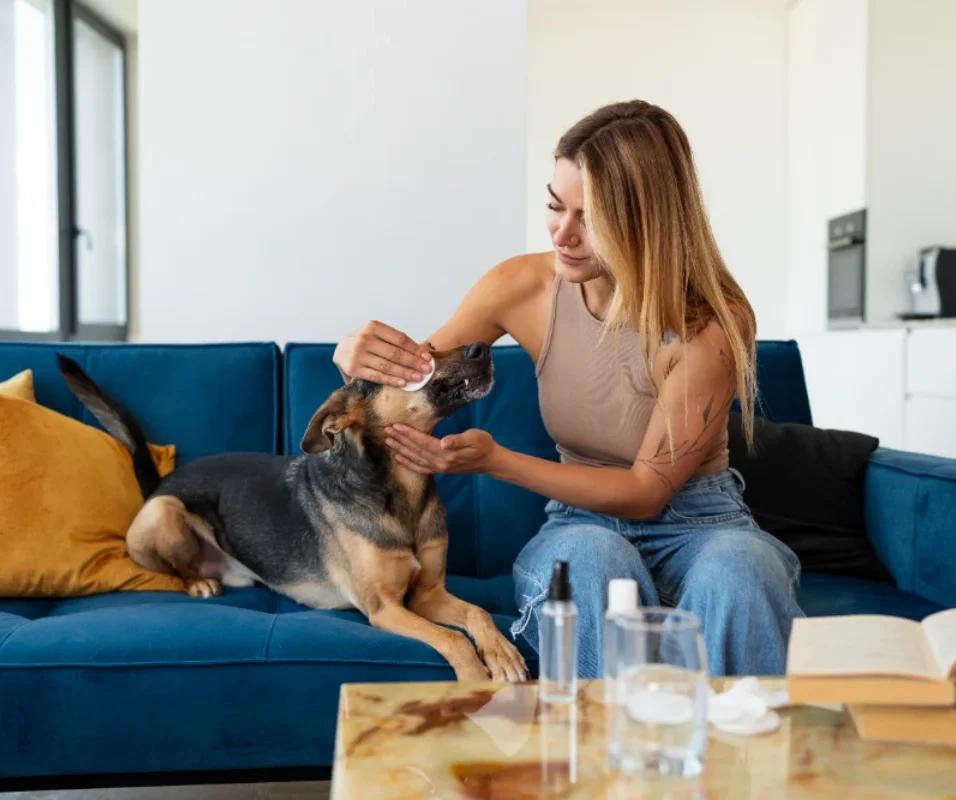Feeding a sick dog requires lots of patience and the right approach to deliver them vital nutrients, especially when your furry friend has lost their appetite. Methods tailored to your condition will work best when feeding. All details about meal times – from choosing foods to making it stress-free – make a difference. Explore our Methods for Feeding Sick Dogs for expert advice and practical solutions.
Methods For Feeding Sick Dogs
There are several different methods available for trying to get your dog to eat. But first, it’s important to understand how long a dog can go without eating. Which method works best will depend on your dog. If the first method doesn’t work, try new ones until you find one that works for you and your dog.
- Offer Soft, Bland Foods
- Warm the Food to Enhance Flavor
- Hand-Feed to Comfort Your Dog
- Add Broth or Wet Food for Flavor
- Use Prescription Diets for Recovery
- Try Appetite Stimulants or Toppers
- Serve Small, Frequent Meals
1. Offer Soft, Bland Foods
Switch to easily digestible foods like boiled chicken, plain rice, or scrambled eggs without seasoning. These are gentle on their stomach and help soothe digestive issues. Ensure the food is free from harmful additives like salt, garlic, or oil. Bland diets are especially effective for dogs recovering from gastrointestinal illnesses. Always introduce new foods gradually to avoid upsetting their stomach further.
Tips:
Ensure no added seasonings like salt, garlic, or onions, as these can be harmful to dogs.
2. Warm the Food to Enhance Flavor
Sick dogs often lose their sense of smell, making food unappealing. Warming their meals can intensify the aroma, encouraging them to eat. Use low heat or warm water to gently heat the food, but avoid making it too hot. Test the temperature with your finger to ensure it’s safe for consumption. This small step can make a significant difference in sparking their appetite.
3. Hand-Feed to Comfort Your Dog
Hand-feeding can create a bond of trust and comfort for a sick dog. Sit beside your pet and offer small pieces of food directly from your hand. This approach reduces stress and encourages reluctant eaters to try their meal. Your presence can provide emotional reassurance, which is crucial when they’re unwell. Be patient, as this method might take time but is often effective.
Why It Works:
This method mimics social eating, creating a sense of connection and trust.
4. Add Broth or Wet Food for Flavor

Adding a little unsalted chicken or beef broth to their foods may make it easier for them to tolerate. Wet food is also a good idea since it’s softer and easier for an ill dog to chew and swallow. Be sure any liquids used contain nothing toxic, such as onions or too much salt. The additional moisture also acts to keep them more hydrated, which is important when a dog isn’t feeling well. This method is suitable for dogs suffering from dental pain or loss of appetite.
5. Use Prescription Diets for Recovery
For dogs with specific health issues, a vet-recommended prescription diet is a sure option. Prescription diets help restore nutrition and are specifically designed to heal what ails them. There are many Hill’s or Royal Canin options for digestive or chronic issues. Check with your veterinarian before adding a specialized diet. A prescription diet will ensure they are getting just the right mix of nutrients for healing.
6. Try Appetite Stimulants or Toppers

Dog-safe toppers like canned pumpkin or plain baby food can make meals more appealing. These additions enhance the taste and texture, encouraging your dog to eat. In more severe cases, your vet may prescribe appetite stimulants like Mirtazapine to help them regain interest in food. Always use stimulants under veterinary guidance to avoid adverse effects. This approach works well for dogs with persistent refusal to eat.
Veterinarian Advice:
Appetite stimulants like Mirtazapine may be prescribed in severe cases.
7. Serve Small, Frequent Meals
Large portions can overwhelm a sick dog’s digestive system. Instead, divide their meals into smaller portions and feed them multiple times a day. This ensures they receive adequate nutrients without putting strain on their stomach. Monitor their intake to track improvement or detect any changes in their condition. A consistent feeding schedule also helps establish a routine, making mealtimes easier for both of you.
When to Consult a Vet Immediately
If your pet will not eat for more than 24 hours and is vomiting, defecating, or showing signs of dehydration, contact a vet right away. Such warning signs include extreme lethargy, weight loss, or apparent pain in eating. These symptoms may sign a more critical underlying condition requiring urgent care. Treatment given early can avoid complications and hasten their return to health. Of course, always err on the side of caution and seek professional advice.








